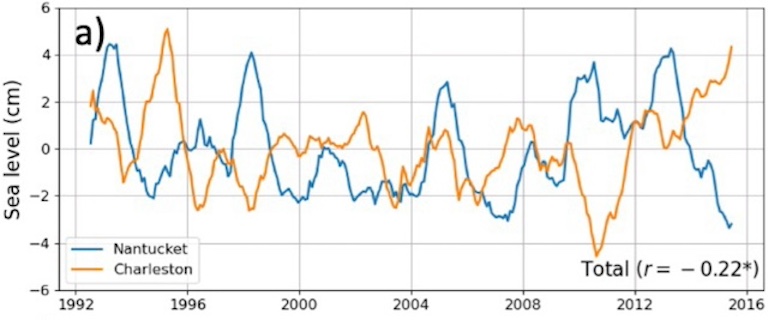News | May 21, 2024
How Winds and Waves Shape East Coast Sea Level
.jpg?disposition=inline)
Researchers studied the region around Charleston, South Carolina to compare the sea level on the southeast and northeast U.S. coasts. Image credit: NASA Earth Observatory
The question: Why do sea levels on the northeastern and southeastern coasts of the United States differ from each other?
The answer: A new study by members of the NASA Sea Level Change Team takes a closer look at sea levels in the two coastal regions, with Cape Hatteras as the dividing line. It reaffirms previous observations – they don’t follow the same trend and, in some cases, run opposite to each other – and also reveals a likely cause.
“The main reason is offshore wind stress,” said Ou Wang, an oceanographer at the Jet Propulsion Laboratory. Wang and his co-authors looked at sea level near Charleston, South Carolina, as a proxy for the southeast coast and Nantucket, Massachusetts, as a proxy for the northeast coast.

“[Offshore wind stress] will have a larger impact on Charleston’s sea level, but has very little impact on the U.S. northeast coast,” Wang said.
Sea level differences across these regions involve several factors, including wind stress from both near and away from the coast, as well as the changes in ocean density due to fluctuating water temperature and the addition of freshwater.
“Wind stress essentially causes mass to move, and ocean density changes affect the ocean circulation,” Wang said.
These factors can also contribute to sea level changes over time.
“[Offshore] wind stress will cause waves [to] propagate westward towards the coastline, and that will affect the coastal sea level change,” Wang said. “Those waves are relatively slow [and] take a few years to cross the basin. For nearshore wind, [the wind] actually causes faster-propagating waves near the coast, known as coastal trapped waves in oceanography. They can usually affect larger swaths of the coastline within a few weeks.”
Why it’s important: Although previous studies showed a lack of correlation between the northeast and southeast sea levels, the latest research allowed the team to identify a likely cause.
Previous studies often used correlation-based approaches, which relate coastal sea level changes to wind stress and circulation changes; however, correlation alone cannot establish causation.
For this study, they did something unique: using advanced models to compute how changes in forces like wind, heating, and freshwater exchange at the ocean surface influence coastal sea level.
The researchers then broke down how much each of these forces individually contributes to sea level change.
By comparing where and how these forces affect coastal sea levels on the northeastern and southeastern U.S. coasts, the researchers were able to pinpoint how specific forces reduce the correlation between sea level changes along the two coastlines.
